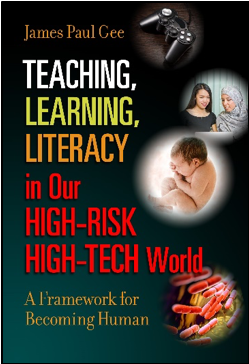Publication Details
| OLOR Series: | ROLE Reviews |
| Author(s): | Cat Mahaffey |
| Original Publication Date: | 15 March 2018 |
| Permalink: |
<gsole.org/olor/rolereviews/2018vol1no2.rev8> |
Publication Note
This review was originally published in Research in Online Literacy, vol. 1, no. 2 (2018).
Resource Overview
Media, Figures, Tables |
Resource Contents
Review of Teaching, Learning, Literacy in Our High-Risk High-Tech World
Have you heard that Millennials lack empathy (Turkle, 2016) and are, in general, mentally unstable? Amid the normal angst that the next generation will hasten the end of civilization we hear real concern about technology’s impact on brain development and social skills. Educators perform a delicate balance between using technology to engage students and limiting the distractions of personal digital devices. Likewise, parents are cautious about the addictiveness of cell phones and tablets and are encouraged to limit their children’s screen time. The truth is that we are treading new waters and the jury is still out as to whether the perpetual push toward more integrated technology is wise or not. And this is where James Paul Gee’s Teaching, Learning, Literacy in Our High-Risk High-Tech World: A Framework for Becoming Human emerges as an informative text. Offering a balance of insight, optimism, and caution, Gee, a prominent scholar on gaming theory, explores the impact of technology on literacy and learning in this new book.
In this book, Gee lays the foundation for what he refers to as a new “framework” for human learning and development. Using the Pareto Principle as a lens, Gee reimagines what parts of literacy development should be nurtured in the classroom and what parts might be better pushed into the real world. The Pareto Principle states that 80% of effects come from 20% of causes. One prominent example for those of us in higher education is how 20% of academics are responsible for 80% of publications. It might seem logical to steer learners toward spaces they excel in so they can rise to the top 20%, but that is not Gee’s vision. Instead, he sees more value in what some might call lurking, hanging out in the bottom 80%, because lurkers explore and learn. They test their passions. Gee believes “every young person, in and out of school, should be able to sample lots of interests [...] and take one or a few far enough to gain a passion and join the top 20%” (p. 82). In other words, learners must immerse themselves and move in and out of enough spaces to discover their passion and then work toward excelling in it, and this new era of connectedness through technology affords those explorations like never before.
While Gee lays out his framework logically and thoroughly, the book falls short of reaching its own full potential as a tool for change. Gee shares many anecdotes that reveal ways learning can occur outside school, but the next step is missing. It is unclear how or where this discussion of learning through technological socialization might take place. Gee seems unwilling to directly take on those reformers who are systematically pushing us in the opposite direction. He discusses how the humanities are essential to language and cultural development, but he does not outright address the risks inherent in the increasing shift toward STEM and the subsequent underfunding of liberal arts resulting from these reforms.
Having said that, in some ways the openness of Gee’s text embodies what he proposes—tapping into our collective expertise to redesign how we teach, parent, and mentor. Higher education continually experiments with ways to address the humanness of our students (I am thinking of the recent emphasis on mindfulness), but we face the reality that our classroom is one among many that students move in and out of. Perhaps as academe continues to push toward interdisciplinary research and practice, we can find spaces to test Gee’s holistic notions of teaching and learning through technology. Overall, even though I’ve discussed this review with higher education in mind, Teaching, Learning, Literacy in Our High-Risk High-Tech World provides insights for every field, discipline, age, or culture. After all, becoming human is something we should all care about.
References
Gee, J. P. (2017). Teaching, Learning, Literacy in Our High-Risk High-Tech World: A Framework for Becoming Human. New York: Teachers College, Columbia University.
Gee. J. P. (2018). Publications. James Paul Gee. Retrieved from http://jamespaulgee.com/publications/
Seal, B. (2016). 3 ways technology is messing with our mental health. In Huffpost. Retrieved From https://www.huffingtonpost.ca/brent-seal/3-ways-technology-alters-mental-health_b_9449708.html
Turkle, S. (2015). Reclaiming Conversation: The Power of Talk in a Digital Age. New York: Penguin Press.
Pareto principle. (2018, February 12). In Wikipedia, The Free Encyclopedia. Retrieved from https://en.wikipedia.org/wiki/Pareto_principle



 Teaching, Learning, Literacy in Our High-Risk High-Tech World: A Framework for Becoming Human
Teaching, Learning, Literacy in Our High-Risk High-Tech World: A Framework for Becoming Human